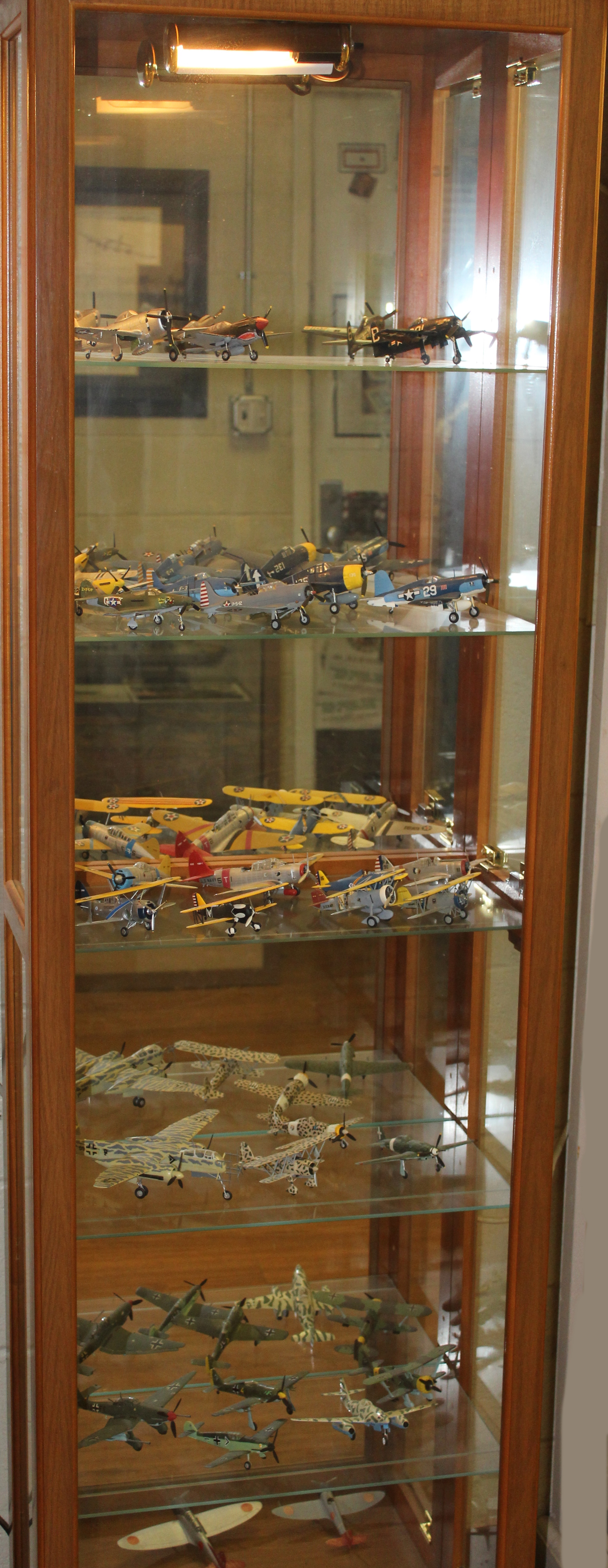- Cabinet 1 Shelf 1
WWII American fighter aircraft
P-47 Republic (Thunderbolt) , US Army Fighter Bomber, ground attack aircraft. 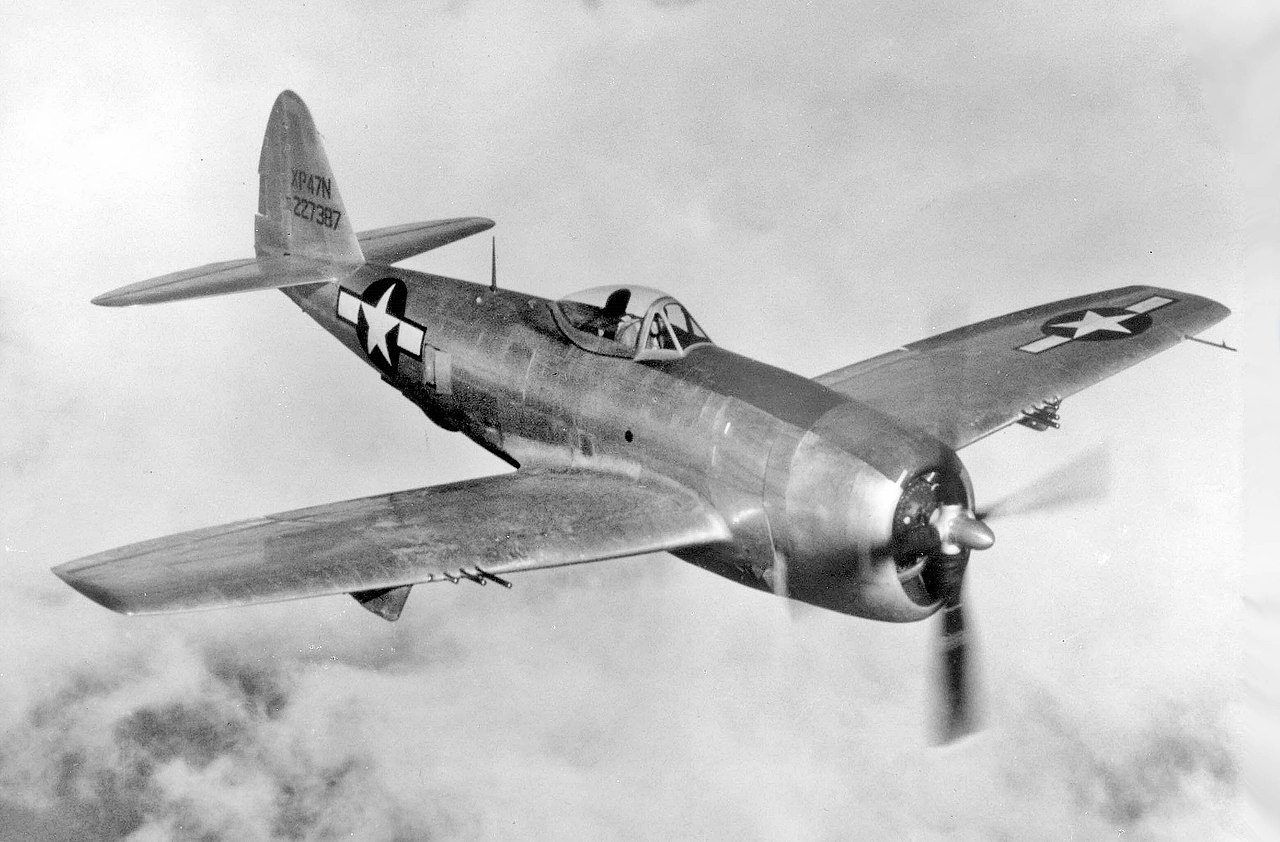
The Republic P-47 Thunderbolt was produced by Republic Aviation from 1941 through 1945. The Thunderbolt was armed with 8 .50 caliber machine guns and could carry a 2,500 pound bomb load. The Republic Thunderbolt served as a fighter-bomber, escort fighter and ground attack aircraft. The Thunderbolt utilized the same Pratt & Whitney R-2800 radial engine as the Gruman F6F Hellcat and the Vought F4U Corsair. The P-47 was one of the most effective USAAF fighter aircraft during WWII and was highly regarded for its firepower and its ability to withstand damage during air combat. The P-47 was designed by Alexander Kartveli of Georgian descent. The P-47 was eventually replaced by the P-51 Mustang.
P-40 Curtiss (Warhawk) US Army Fighter, US Flying Tigers (China)

The P-40 Curtiss Warhawk is an American made single seat, single engine fighter and ground attack aircraft. The P-40 was an improved re-design of the Curtiss P-36 Hawk. The Warhawk was used by most Allied nations during WWII. It was the third most produced fighter aircraft of WWII. Over 13,000 were produced. The Curtiss Warhawk first saw action in the North Africa campaign in 1941. The P-40 played a significant role in North Africa, the Pacific and in China. The P-40 was originally designed to serve as a pursuit aircraft. It was very agile at low and medium altitudes, but had decreasing performance at high altitudes. The structural strength of the design of the P-40 allowed it to perform high speed turns and maneuvers. The design was very robust and allowed the aircraft to tolerate some damage and remain flying. The range of the P-40 was roughly similar to the Messerschmitt Bf 109. The P-40 gained it's fame as the aircraft used by the American Volunteer Group (The Flying Tigers) as pictured above.
P-51 Mustang US Army Fighter

The P-51 Mustang is a single seat single engine aircraft produced by North American Aviation. It was used primarily in WWII and the Korean War. It entered service in 1942 with the RAF. It was designed to serve as reconnaissance aircraft and fighter bomber. The P51-D version was powered by the Packward V 1650-7 two speed two stage supercharged Merlin 66 engine. It was armed with six .50 caliber M2 machine guns. The P-51 was used to escort bombers in raids over Germany and helped to ensure Allied air-superiority over the Luftwaffe. The P-51 also served in the Korean War and remained in service into the 1980's. As bomber escort, the P-51 had adequate fuel capacity to accompany bombers from England to Germany and back. The Mustang was considered to be far superior to all previous US fighter aircraft. The P-51 was able to out perform competing German aircraft such as the Fock-Wolfe 190 and the Messerschmitt bf 109. It is claimed that Reichmarschall Herman Goering said the the appearance of the P-51 signified the beginning of the end for the Luftwaffe.
P-39 Bell (Airacobra) US Army Fighter
The P-39 Airacobra was produced by Bell Aircraft for the US Army Air Forces. The P-39 is a low-wing single engine fighter. An interesting feature of the aircraft is its mid-fuselage Allison V-1710 liquid cooled V12 engine which drove the propeller using a 10 ft long shaft which ran underneath the cockpit. The P-39 was designed to serve as a platform for the 37mm T-9 cannon and the entire structure was made to support this purpose. The pilots seat was located above the drive shaft for the propeller so the pilot was positioned higher that other similar aircraft and as a result, had a better view. The P-39 D model was armed with two .50 caliber and four .30 caliber machine guns. The heavy weight of the aircraft and the limited performance rendered the P-39 inferior to European aircraft of the period.
- 2nd Shelf (L to R)
Douglass (TBD Devastator) US Navy Dive Bomber

The Douglass TBD Devastator is a US Navy torpedo bomber. The Devastator entered service in 1937 and at the time was considered one the most advanced aircraft in the world. With the fast pace of technology it quickly became outclassed. The Devastator performed well during the early days of the Pacific campaign. The torpedo carried by the Devastator was the problematic Mark 13, problems with which greatly limited the effectiveness of the aircraft. The Devastator was slow with a top speed of only 200 mph. It also had poor maneuverability which made it vlnerable to enemy aircraft. Poor perfomrance of the aircraft at the Battle of Midway in 1942 resulted in removal from service of the Douglass Devastator. None of these aircraft have survived in museums or private collections.
Brewster Buffalo F-2A US Army Fighter
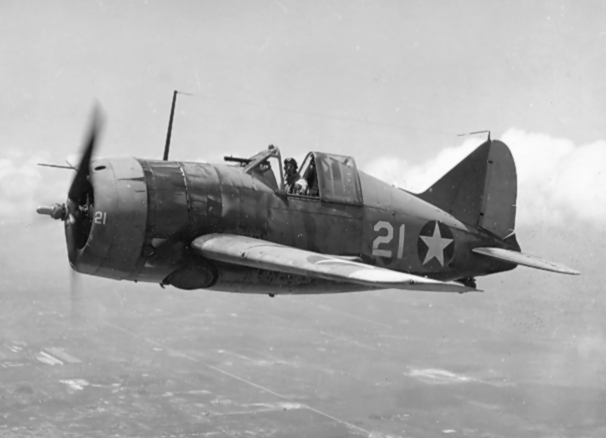
The Brewster F2A-2 Buffalo is an American monoplane fighter aircraft. The F2A-2 was introduced early in World War II and was one of the first such aircraft to be fitted with an arrester hook for use on aircraft carriers. The F2A-2 was the US Navy’s first monoplane fighter aircraft. The F2A-2 was considered to be unstable and overweight compared to the Japanese Mitsubishi Zero. Several nations procured the F2A-2 including Finland, whose air force used them very effectively against Soviet aircraft. Three variants of the Brewster Buffalo were made for the US Navy: the F2A-1, the F2A-2 and the F2A-3. The F2A-3 was employed by the US Marine Corps at Midway and was found to be inferior to the Japanese Zero. The Brewster Buffalo was all-metal with flush rivets and stressed aluminum construction. The aircraft lacked self sealing fuel tanks and had no armor to protect the pilot. The F2A-2 was powered by a 950 HP Wright Cyclone radial engine. These aircraft were some of the first aircraft to be tested in wind tunnels, a practice which soon became standard. The US Navy ordered 43 of the F2A-2 model which was equipped with two machine guns and had a top speed of 320 mph. By 1940, the Brewster Buffalo was considered obsolete. F2A-3 Buffalos participated in the battle of Midway in 1942. 13 out of 20 F2A Buffalos were lost in engagements with Japanese Zeros. Today, the only specimens of the Brewster Buffalo in existence are models built for export preserved in Finland. A total of about 500 aircraft were produced.
Gruman (Wildcat) US Navy Fighter

The Gruman Wildcat is a carrier based fighter aircraft that served with the US and British Royal Navy. The Wildcat was known to the British as the Martlet. It was first introduced into service in 1940. The Gruman Wildcat replaced the Brewster Buffalo and was considered to be the most capable fighter available to the Navy in the Pacific Theater. The Wilddcat was slower than the Zero, but very rugged. Its self sealing gas tanks and heavy armor allowed the Wildcat to take more damage than the Zero. The Wildcat was also equipped with a homing device which helped them find their carriers in poor visibility. The Gruman Wildcat played a significant role in the campaigns of Guadalcanal, Wake Island, the Battle of Coral Sea and the Battle of Midway. The Wildcat was replaced by the F6F Hellcat in 1943. Over 7,800 were produced.
Douglass (Dauntless) US Navy Dive Bomber

The Douglass SBD Dauntless is an American dive bomber manufactured by Douglass Aircraft introduced in 1940. The Dauntless was the primary carrier based dive bomber during the majority of WWII. The Dauntless has very good handling characteristics, long range capability and could carry a good bomb load. The Dauntless was armed with two forward firing .50 caliber machine guns and two .30 caliber rear firing machine guns. The Dauntless played a significant role in the Battle of Coral Sea and the Battle of Midway. The SBD Dauntless proved to be a major threat to Japanese shipping during the Guadalcanal campaign. The Battle of the Philippine Sea was the last major battle employing the Dauntless. Over 5,900 were produced. The Dauntless was replaced by the Curtiss Helldiver.
Gruman (Hellcat) US Navy Fighter

The Grumman F6F Hellcat is an American made carrier based fighter aircraft and is the successor to the F4F Wildcat. The F6F was introduced in 1943 and became the dominant US Navy fighter during the later stages of the Pacific War. The F6F was powered by the Pratt & Whitney R2800 engine also used by the Corsair Vought and the Republic P-47 Thunderbolt. It quickly earned a reputation as an capable and reliable fighter aircraft and it tipped the balance of air superiority to the Allies. The F6F was designed to counter the Japanese Zero and was considered successful in doing so. The F6F was also designed for ease of manufacture, rugged reliability, excellent flight characteristics and a capacity to endure damage and continue flying. The fuselage was sloping in front which gave the pilot better visibility. By the time the last Hellcat was produced in 1945, over 12,000 had been produced. The Hellcat was credited with 5,223 enemy aircraft kills, more than any other Allied navy aircraft. The F6F was armed with six .50 caliber M2 machine guns, had fully retractable landing gear, an armored cockpit and a bomb load of 2,000 pounds. The F6F was later replaced by the F8F Bearcat.
Chance Vought (Corsair) US Navy Fighter 
The Vought - Corsair F4U was an American fighter aircraft designed to be operated from carriers. It was introduced in large numbers with the US Navy in 1944 and 1945. The F4U was highly regarded as one of the most effective fighter bombers of WW II. The Corsair also served in the Korean War and was used by the French in the First Indochina War. The Corsair was still in use by some air forces of the world until 1962. Over 12,000 were produced. The F4U utilized the largest aircraft engine available at the time, the 2,000 HP 18 cylinder Pratt and Whitney R-2800 radial engine. For use on carriers, the F4U was designed with folding inverted Gull wings. The F4U was the first US Navy aircraft to feature landing gear that were fully retractable into an enclosed wheel well. The Corsair was the last American produced aircraft to feature fabric as the skin for the wings, ailerons, elevators and rudder. The Corsair was eventually replaced by the F6F Hellcat. The aft mounted cockpit and nose up attitude of the plane made it difficult for pilots to see straight ahead while taxiing. The F4U was considered to be superior to the Brewster Buffalo and the Grumman Wildcat. The F4U was armed with six .50 caliber M2 Browning machine guns and could carry 2,300 rounds.
- 3rd Shelf (L to R)
SBC-4 Curtiss Helldiver US Navy scount / dive bomber
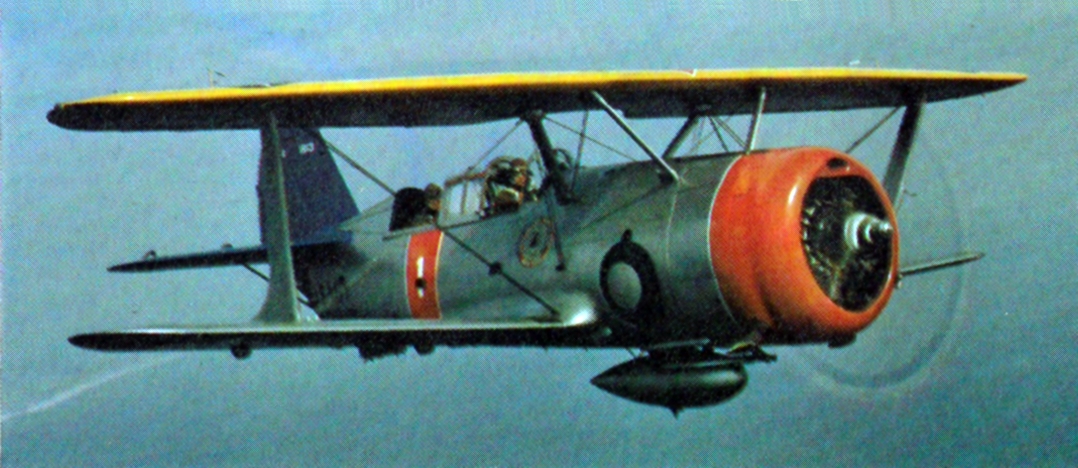
The Curtiss SBC-4 Helldiver was a two seat scount / dive bomber produced for the US Navy by the Curtiss Wright corporation. It was introduced in 1937 and was the last military biplane produced for the US Navy. It was considered obsolete by the beginning of WWII. The SBC-4 had a crew of two: a pilot and radio operator/gunner. The wings, rudder, elevators and flaps were fabric covered. The aircraft also had retractable landing gear. The most advanced varient, the 77B was powered by a 950 HP radial engine. It was armed by one .50 cal machine forward and one rear firing .30 caliber machine gun. The SBC-4 had a bomb payload of 1,000 pounds.
P-26 Boeing (Peashooter) US Army Air Corp Fighter
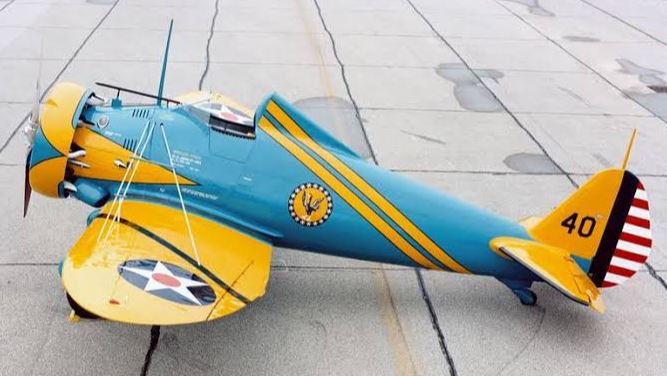
The Boeing P26 was the first all metal American produced fighter aircraft . It was designed and built by Boeing in 1932. This aircraft has an open cockpit, fixed landing gear and an externally braced wing design. The P-26 had a top speed of 230 MPH, a combat range of 360 miles and was armed with 2 .50 caliber M1919 Browning machine guns and could carry 2 100 lb GP bombs. By 1941, new aircraft designs rendered the P-26 completely obsolete.
P-6 Curtiss (Hawk) US Army Air Corp Biplane Fighter
The Curtiss Hawk is an American made single engine, single seat biplane fighter. It was introduced into service with the US Army Air Corps in the late 1920s. During its time in service, its top speed of 200 mph was considered to be very fast. The P6 was operated between 1932 and 1937. A total of 70 aircraft were produced. One surviving aircraft remains at Patterson Wright AFB near Dayton, Ohio.
P-36 Hawk US Army Fighter
The P-36 Hawk is an early American designed fighter aircraft made by Curtiss-Wright. The P-36 was based on a new design concept and made extensive use of metal structure and was powered by a powerful radial engine. The P-36 had a top speed of about 280 mph and was armed with a .30 and .50 caliber machine guns mounted in the cowling which fired through the propeller arc. The P-36 lacked armor and self sealing gas tanks. The P-36 had landing gear that rotated 90 degrees as they retracted into the wheel wells which was a feature patented by Boeing. The P-36 had a high power-to-weight ratio and low wing loading which yielded very favorable flight capability. The P-36 Hawk saw little use with the US Army Air Force, but was heavily used by other nations including France, China and the UK.
Curtiss F11C-2 Goshawk US Army Fighter

The F11C-2 was an American made biplane fighter aircraft built by the Curtiss Aeroplane and Motor Company. The Goshawk was equipped with a 600 hp radial engine, had single leg cantilever landing gear units and was armed with two .30 caliber machine guns. It was also capable of carrying an external fuel tank or a single bomb. The Goshawk was designed to be a fighter bomber. A total of only 26 were made and these were briefly operated by the carriers Saratoga and the Enterprise. Export versions were provided to the Chinese Nationalists and the Colombian Air Force, Bolivia, Germany and Cuba. German Goshawks performed acrobatic maneuvers at the 1936 Olympics, one of which, survives today at the Polish Aviation Museum in Krakow, Poland.
P-12 Boeing US Army Fighter
The Boeing P-12 was an American made aircraft operated by the US Army Air Corps, Marine Corps and the US Navy. It was designed to replace the Boeing F2B. The P-12 made its first flight in 1928. Over 500 were produced during 1929 through 1932. The P-12 utilized a welded truss fuselage and wings made of wood covered with fabric. The aircraft was powered by a Pratt & Whitney R-1340 500 hp nine cylinder radial engine. The P-12 was designed to be a pursuit aircraft. It had a maximum speed of 190 mph and a ceiling of 26,000 ft. The P-12 was typically armed with two .30 caliber machine guns with 600 rounds per gun.
- 4th Shelf (L to R)
HE 219 (Heinkle) German twin-engined night Fighter

The Heinkel He 219, also known as the Eagle-Owl is a German Luftwaffe night fighter introduced in 1943. The He 219 was designed to hunt down allied bomber aircraft. The He 219 is considered to be a sophisticated design and possessed advanced technology for the period, including the Lichtenstein VHF intercept radar system, a three wheeled landing gear and ejection seats. Because of technical issues and allied bombing of manufacturing facilities, only 294 of these were produced during WWII. With the Lichtenstein Radar System, ground control sent the aircraft into the general area of targeted enemy aircraft and pilots guided themselves using the radar information. This radar required use of very distinctive large high-drag 4x2 dipole element antenna array. The A-0 variant was armed with two 20 mm cannon in the wing roots, and up to four additional cannon in a ventral weapons bay.
CR 42 Fiat (Falco) Italian Biplane Fighter

The Fiat CR 42 Falco is a fighter aircraft produced by Fiat Aviazione. The Falco was introduced in 1939 and utilized by the Italian, Spanish, Belgian, and Swedish air forces during WWII. The Falco is considered a "sesquiplane" which is a biplane configuration where the lower wing is substantially smaller than the upper wing. The CR 42 was very agile and maneuverable, but was outclassed by more modern single wing aircraft. The Falco was known to be capable of executing extremely tight half rolls. The Falco was the last biplane to be produced by Fiat. About 1800 were produced. The Falco saw action in the Battle of France, Battle of Britain, Malta, North Africa, and Greece. The variant known as the CR42 DB was the fastest biplane to have ever flown with a top speed of over 320 mph. The CR42 was equipped with fixed landing gear with wheels housed in streamlined fairings. Compared to other contemporary fighter aircraft, the Falco had limited firepower, armor protection and radio capability.
M 200 Saetta (Macchi) Italian Fighter
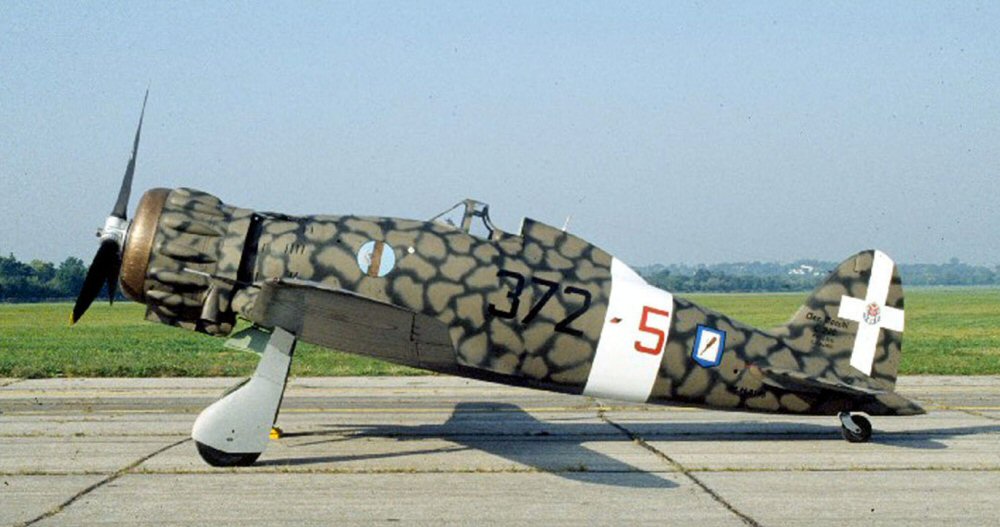
The Macchi C.200 was a fighter aircraft made by Italian manufacturer Aeronautica Macchi. It was operated by Regia Aeronautica during the Second World War. The M200 was a monoplane design with retractable landing gear, enclosed cockpit and a radial engine. The fuselage was designed to provide a slightly elevated cockpit to provide the pilot with better visibility. The M200 possessed excellent flight characteristics and flew more sorties than any other Italian aircraft. The aircraft was capable of achieving speeds in excess of 500 mph in a dive. The Macchi C.200 saw service in Yugoslavia, Greece, North Africa, Mediterranean, and in the Soviet Union. The Macchi was designed to serve as a ground attack aircraft. Over 1,000 were produced. The Macchi was powered by a Fiat A 74 radial engine which produced 870 HP. Armament for the aircraft was typically a pair of 12.7 mm Breda machine guns. The Macchi was nicknamed the Saetta, or Arrow.
M 202 Folgore (Macchi) Italian Fighter 
The Macchi M202 Thunderbolt was an Italian fighter aircraft manufactured by Macchi Aeronautica and operated by the Italian Air Force. The M202 was an evolution of the earlier Macchi M200 and was considered to be one of the best aircraft to serve with Regia Aeronautica. The M202 was introduced in 1941 and saw action in all fronts of Italian military campaigns, including Malta and North Africa. In North Africa, the Folgore had a higher kill/loss ration than the German Messerschmitt bf 109.
- 5th Shelf (L to R)
Ju-87 Stuka (Junkers ) German Dive Bomber

The Junkers Ju 87 "Stuka" was a German aircraft designed primarily for dive bombing and ground attack roles. The Stuka was introduced into military service with the Condor legion in the Spanish Civil War in 1937. The Stuka was also heavily used by Axis forces in WWII. The Stuka is an iconic and easily recognizable aircraft with inverted gull wings and fixed landing gear. The Stuka is also known for its wailing sirens called Jericho Trumpets. The gull wing shape enhanced the pilots visibility and allowed a shorter undercarriage height. The Ju 87 was a single engine fixed wing monoplane and could carry a crew of two. It was constructed completely of metal using Duralumin. It was also designed for ease of maintenance and field repair. The Ju 87 was also designed to utilize and automatic system to pull the aircraft out of a dive in case where the pilot may be incapacitated by high g-forces. The Ju 87 was armed with two 7.92 machineguns in each wing and one located in the rear of the cockpit operated by the second crewman which also served as radio operator. The Stuka typically performed dive bombing at 60-90 degrees and a speed of 350 mph. The maneuver frequently generated high g forces that were very stressful on pilots as the aircraft could fly nearly vertical. because of the high g-forces pilots were subjected to, extensive medical testing was performed by personnel at the Junkers manufacturing facility evidence of which was discovered by Allied forces when it was captured in 1945. The Ju 87 was eventually replaced by the Focke-Wulf FW 190. In the Operation Barbarossa and Citadel, the Stuka played a key role and was extremely effective in destroying ground targets such as vehicles, tanks and trains. The Ju 87 was powered by a V12 liquid cooled piston engine generating 1,200 HP.
ME-109 (Messerschmidtt) German Fighter

The Messerschmitt Bf 109 is a German WW II aircraft and was one of the most advanced of the time with such features as retractable landing gear and an enclosed cockpit and all metal construction. It was designed as an interceptor but served in a variety of roles including bomber escort, fighter-bomber, ground attack and reconnaissance. The Me 109 was first introduced into service during the Spanish Civil War and was still used until the end of WWII. The Bf 109 was one of the principal aircraft of the Luftwaffe. The Bf 109 is also the most produced fighter aircraft in history with over 33,900 produced. The Bf 109 was designed with a priority placed on ease of access to the engine compartment, and weapons system at forward operating bases. The entire engine assembly could be replaced in minutes. The Bf 109 was armed with two machine guns mounted in the cowling which fired through the propeller arc. There also existed a design to place a cannon inside the engine cylinder assembly known as Motorkanone. Some Bf109 aircraft were manufactured at the Gusen concentration camp in Austria and some were also produced at the Messerschmitt plant in Regensburg in Bavaria. More aerial kills were made by the Bf 109 than any other aircraft of World War II.
FW-190 (Focke-Wolf) German Fighter

The Focke Wulf 190 is a German single seat, single engine fighter aircraft introduced in the late 1930's. The Fw 190 was heavily used in WWII and was a principle aircraft of the Luftwaffe. It served in fighter aircraft, fighter-bomber and ground attack roles. The Fw 190 first saw action during WWII in France in 1941. The Fw 190 was an exceptional aircraft and was superior to the British Spitfire and gave the Axis air forces superiority over Allied fighters for some time. The FW 190 was regarded as one of the best fighter aircraft of WWII. The design for the FW 190 was somewhat inspired by US Navy aircraft designs which used radial engines with streamlined cowlings which reduced otherwise high drag produced by air cooling required for the engine configuration. Among other new innovations, the Fw 190 was designed with pushrods and bearings instead of cables for operating control surface which eliminated problems caused by cables that stretched over time. It also made use of electricaly powered systems over hydraulic power. Armanent was electrically loaded and fired.
ME-262 (Messerschmidtt) German Jet Fighter

The Me 262 was the worlds first jet powered fighter aircraft. The Me 262 was faster and more heavily armed than any allied fighter of the period. The me 262 did not enter full operation status until 1944. It was one of the most advanced designs of World War II and served as light bomber, reconnaissance aircraft and night fighter. Its late introduction into the war and production issues limited its impact despite its special qualities. Study of captured Me 262 aircraft influenced the design of many post war military aircraft including the F-86 Sabre, the Mig 15 and the Boeing B-47. When first designed in 1939, the engine was mounted in the central fuselage as is seen in many conventional jet fighters. During development, the engines were instead mounted on wing pods to allow more frequent refitting for new engine designs. The Me 262 had a cruising speed of 460 mph but could attain a top speed of over 500 mph, fast enough to sometimes tear off the bomb racks. The Me 262 was so capable and effective in the air that allied pilots learned to attack the Me 262 primarily during takeoff, landing or when on the ground. About 1400 of the Me 262’s were produced. Late at the end of the war, Me 262 aircraft were assembled in underground facilities such as B8 Bergkristall-Esche II in St Georgen/Gusen Austria.
HE 123 (Henschell) German Biplane Dive-bomber

The Henschel Hs 123 was a single seat biplane dive bomber produced by German locomotive manufacturer Henschel. The Hs 123 was first introduced into service with the Luftwaffe in 1936. The Hs 123 was a sesquiplane biplane. Its lower wings were smaller than the upper wings. Although its design was based on already obsolete aircraft concepts, the Hs 123 was very relaible and rugged. It was capable of pulling out of near vertical dives. The aircaft could absorb damage and continue to operate. Its radial engine was less vulnerable to small arms fire than the liquid cooled engine of the Bf 109. The Henschel Hs 123 was designed to serve in a ground attack role. It could carry a 1,000 bomb load and was armed with 2 7.92 mm M17 machine guns. Its primary limitation was its short range of 500 miles. Its top speed was 200 mph. The aircraft played an important part in the Spanish Civil War, Operation Barbarossa and participated in the battle of Moscow.
- 6th Shelf (L to R)
Zeros (Mitsubishi) Japanese Fighter

The Japanese Zero was a long range carrier based aircraft manufactured by Mitsubishi Aircraft Company. The Zero was operated by the Imperial Japanese Navy from 1940 until 1945. This plane was also referred to as the “Zeke”. The popular name Zero was derived from the last digit of the Imperial calendar year in which it was first produced, 2600. The Zero was considered to be the best designed and most capable carrier based fighter aircraft in the world when it was first introduced in 1940. The Zero was very effective in aerial combat and had an outstanding kill ratio. Improvements in Allied fighter aircraft design soon nullified the superiority of the Zero. The Zero served on a front line role until the end of the war in the Pacific. The Zero was the most produced Japanese fighter aircraft. The Zero was very advance for its time and utilized a low-wing monoplane design with retractable landing gear and an enclosed cockpit. The Zero was designed to be very light weight and as such was not well armored. This later proved to be a vulnerability for the Zero in dogfights against more modern and well armored Allied aircraft. The Zero was also made of a special top secret aluminum alloy. The model 21 Zero had an impressive range of 1600 miles. The Zero fighter aircraft served in China, Pearl Harbor, the Battle of the Coral Sea and Guadalcanal. 11,000 Zero planes were built. The Zero had a top speed of 330 mph, a ceiling of 33,000 ft and had a crew of 1 man.



